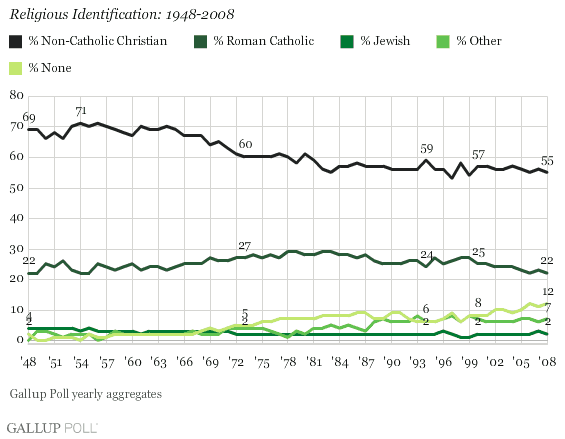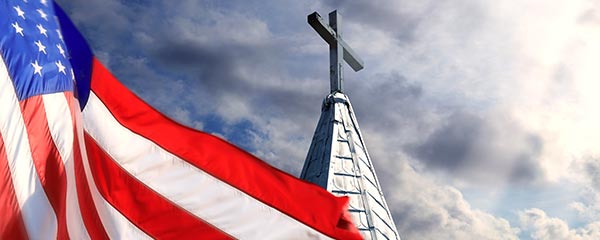PRINCETON, NJ -- The percentage of Americans who identify with some form of a Christian religion has been dropping in recent decades, and now stands at 77%, according to an aggregate of Gallup Polls conducted in 2008. In 1948, when Gallup began tracking religious identification, the percentage who were Christian was 91%.

Christian America comprises those who in response to a basic religious identity question say they are Roman Catholic or some form of a non-Catholic Christian religion. The latter group consists of those who identify themselves as Protestant or as Christian in some other way. An analysis shows that it is this group of non-Catholic Christians that has, on a percentage basis, dropped the most over the decades.

As seen in the accompanying graph, the percentage of Americans identifying as Protestant or another non-Catholic Christian religion has been declining since the mid-1960s. When Gallup began tracking religious identification, the percentage of U.S. adults identifying with some non-Catholic Christian religion was routinely in the high 60%-low 70% range. The percentage fell below 60% for the first time in 1979, and since 2000 has been between 55% and 57%.
The percentage of Americans identifying as Roman Catholic has stayed within a range between 20% and 30% over the last 60 years. Catholics were 22% of the U.S. adult population in 1948, according to Gallup's estimates. That percentage rose over the years and reached its high point in the 1970s and 1980s, when the U.S. population was nearly 30% Catholic. In the last several years, Gallup's estimate of the percentage Catholic has been 22% to 23%.
The relative shrinkage of the Christian percentage of the U.S. population in recent years means that other groups by definition have expanded. The Gallup trend data show that the most significant expansion has come among the group that does not identify with any religion, followed by a more modest expansion of those who identify with another, non-Christian, religion.
The accompanying graph shows Gallup trends since 1948 in the percentage of Americans saying they have no religious identity.

In 1948, 2% of Americans interviewed by Gallup volunteered that they had "no religion." The number stayed in that range until about 1970. By 1972, Gallup had measured 5% with "no religion." Gallup trends show the percentage gradually increasing since that time, with a very modest decline from an average of 8% in the early 1990s to 6% from 1993-1995, and then some fluctuation in the late 1990s, with the percentage settling in the 9% to 12% range since 2002. (Additionally, in 2008, an average of 3% of Americans did not answer the question on religious identity. Whether these people truly do not have a religious identity, or were confused or had several religious identities, is unknown.)
The group of Americans who are classified as "Other" includes the less than 1% who are estimated to be Muslim, and small percentages who are Buddhist, Hindu, or other non-Christian religions. The percentage of Americans classified in this Other category was near 0% in 1948, but was at 3% in 1949 and was generally in the 2% to 3% range through the 1950s and 1960s. It has risen in recent decades to as high as 8% in 1997, and is 7% today.
Implications
The United States remains a dominantly Christian nation. More than three-quarters of all Americans identify as Christian. And the vast majority of those who identify with any religion say they are Christian in some form or another.
Yet, the percentage of Americans who in theory could celebrate Easter this weekend as part of their religion is down significantly from where it was 50 or 60 years ago.
There are many theoretical explanations for the increase in those with no religious identity at the expense of those identifying with a Christian religion. Two social scientists at the National Opinion Research Corporation, Tom W. Smith and Seokho Kim, contemplating similar data from the General Social Survey in 2004, concluded: "In sum, an array of social forces from cohort turnover, to immigration, to reduced retention rates, indicate that the Protestant share of the population will continue to shrink and they will soon lose their majority position in American society."
The share of the population held by any religious group is based on a complex set of factors relating to internal reproduction (births), in-migration (from converts and from people moving into the country who have a particular religious identity), and out-migration (people who leave the religion and people with a particular religious identity who leave the country). In-migration from other countries in recent years may have helped boost the percentage of non-Christians in the population. In-migration from Catholic Mexico and Catholic Central American countries has also, at the same time, helped keep the percentage of Catholics as high as it is. The big shift has apparently been the out-migration of those whose parents may have identified with a specific Christian religion, but who upon growing up have become more likely to tell a survey interviewer that they have no specific religious identity.
Gallup (and other survey researchers) measure religious identity by asking Americans to name their religion. It is possible that Americans who previously would have identified themselves with the religion of their upbringing now feel freer to tell a survey interviewer that they have no religious identity.
It is important to note that basic religious identification says little about the relevance of that identify to the person's life. Identifying with a religion doesn't indicate how actively the individual practices the religion. It doesn't indicate whether the person rigorously adheres to that religion's beliefs. It simply states that the person has some connection to and some identity with a specific type of religion. Data from measures of religious intensity or commitment are needed to flesh out the portrait of the ways in which Americans' religiosity may have changed over the years.
Gallup survey data on religious identification extend back only to 1948, about a quarter of the life of the country. Obviously, this evidence speaks only to the recent history of religious identity in the United States. There is no real scientific way of putting recent survey history of religious identity into a longer time frame going back much before World War II. (Some scholars argue that, in fact, Americans were not very religious by some measures at the time of the Revolution in Colonial America.) It is thus important to keep in mind that the trends reviewed in this analysis are only part of the portrait of the ebb and flow of religion in the United States since the nation's founding well over two centuries ago.
Survey Methods
These results are based on aggregates of Gallup Poll surveys for each year from 1948 through 2008. The sample sizes are provided in the accompanying table.

